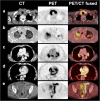PET/CT imaging for tumour response assessment to immunotherapy: current status and future directions
- PMID: 33200246
- PMCID: PMC7669926
- DOI: 10.1186/s41747-020-00190-1
PET/CT imaging for tumour response assessment to immunotherapy: current status and future directions
Abstract
Recent immunotherapeutic approaches have evolved as powerful treatment options with high anti-tumour responses involving the patient's own immune system. Passive immunotherapy applies agents that enhance existing anti-tumour responses, such as antibodies against immune checkpoints. Active immunotherapy uses agents that direct the immune system to attack tumour cells by targeting tumour antigens. Active cellular-based therapies are on the rise, most notably chimeric antigen receptor T cell therapy, which redirects patient-derived T cells against tumour antigens. Approved treatments are available for a variety of solid malignancies including melanoma, lung cancer and haematologic diseases. These novel immune-related therapeutic approaches can be accompanied by new patterns of response and progression and immune-related side-effects that challenge established imaging-based response assessment criteria, such as Response Evaluation Criteria in Solid tumours (RECIST) 1.1. Hence, new criteria have been developed. Beyond morphological information of computed tomography (CT) and magnetic resonance imaging, positron emission tomography (PET) emerges as a comprehensive imaging modality by assessing (patho-)physiological processes such as glucose metabolism, which enables more comprehensive response assessment in oncological patients. We review the current concepts of response assessment to immunotherapy with particular emphasis on hybrid imaging with 18F-FDG-PET/CT and aims at describing future trends of immunotherapy and additional aspects of molecular imaging within the field of immunotherapy.
Keywords: Antigens (neoplasm); Fluorodeoxyglucose F18; Immunotherapy; Positron emission tomography computed tomography; Receptors (chimeric antigen).
Conflict of interest statement
All authors declare that they have no relationships or interests that could have direct or potential influence or impart bias on the work.
Figures



References
-
- Sharpe AH, Pauken KE (2018) The diverse functions of the PD1 inhibitory pathway. Nat Rev Immunol 18:153–167. 10.1038/nri.2017.108 - PubMed
-
- Champiat S, Ferrara R, Massard C et al (2018) Hyperprogressive disease: recognizing a novel pattern to improve patient management. Nat Rev Clin Oncol 15:748–762. 10.1038/s41571-018-0111-2 - PubMed
-
- Friedman CF, Proverbs-Singh TA, Postow MA (2016) Treatment of the immune-related adverse effects of immune checkpoint inhibitors: a review. JAMA Oncol 2:1346–1353. 10.1001/jamaoncol.2016.1051 - PubMed
Publication types
MeSH terms
LinkOut - more resources
Full Text Sources
Medical
